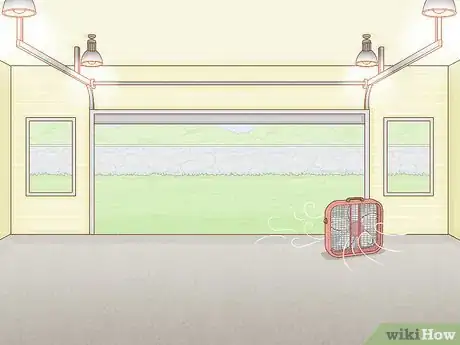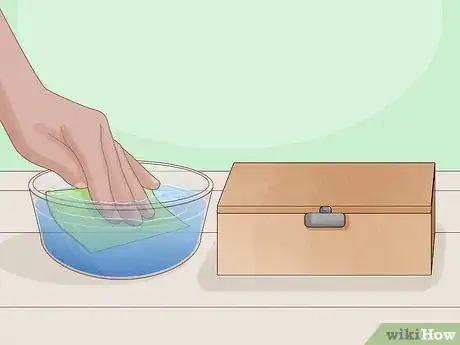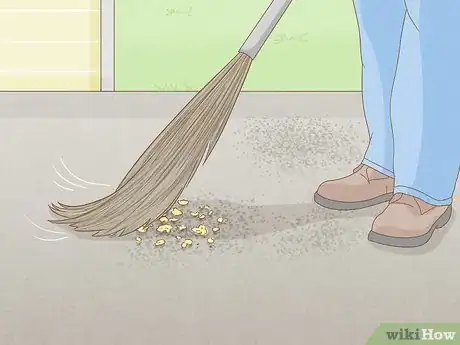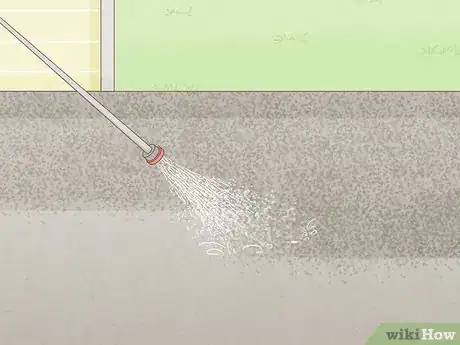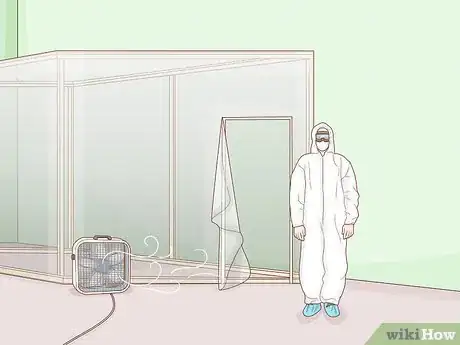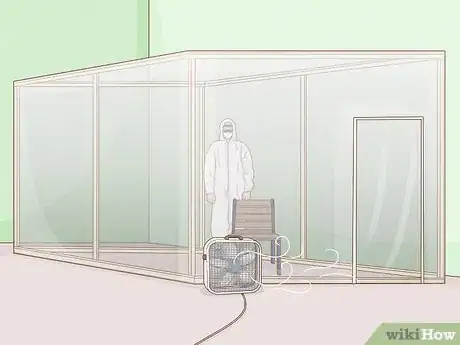This article was co-authored by Ez's Painting LLC. Ez's Painting LLC is a team of Painting Professionals based in Olympia, Washington. With more than twelve years of experience, the EZ's Painting team specializes in both commercial and residential painting projects. Ez's Painting LLC holds a contractor license in the state of Washington.
This article has been viewed 14,775 times.
If you’ve ever tried spray painting around a lot of dust, you know how nearly impossible it is to prevent dust particles from getting in your paint finish. Luckily, there are some measures you can take to help mitigate the ever-present problem of all that annoying dust. With the right precautions and a clean workspace dedicated to spray painting, you’re sure to notice just how much better your paint jobs look!
Steps
Workspace Prep
-
1Work in a well-ventilated space so dust doesn’t linger. Open up doors and windows to create natural ventilation or work in an area that has fresh air ducted in. Good fresh air circulation dilutes the amount of dust in the air.[1]
- For example, if you’re working in a garage, open up the garage door as well as any other doors and windows in the garage all the way.
- If you have a fan available, position it in a window or door and aim it outwards to suck out air and dust.
-
2Wet-sand your projects whenever possible to keep dust down. Use wet/dry sandpaper and wet your project and your sandpaper with water before you sand it prior to spray painting, if it’s practical to do so. This greatly reduces the amount of dust generated by sanding and keeps dust particles out of the air.[2]
- Wet sanding also helps give the object you’re spray painting a smooth, scratch-free finish before you paint it.
Advertisement -
3Vacuum your workspace to most effectively remove dust. Use a shop vac or another type of vacuum with a hose attachment. Suck up dust and debris from all the surfaces in your work area to clean it before spray painting.[3]
- Shop vacs are the best type of vacuum to use for this because they’re very powerful and specifically made to clean up dust from sanding and other activities that generate a lot of dust.
-
4Sweep your work area carefully if you don’t have a vacuum. Use a broom to sweep all the dust and dirt into a neat pile. Carefully sweep it into a dust pan and dump it out in a trash can or other waste container.[4]
- Sweeping does send a certain amount of dust into the air, so give the lingering dust some time to settle again before you spray paint in the area.
- Avoid using compressed air to blow dust out of your work area. This just sends dust particles flying all over the place that linger in the air.
-
5Wet the floor of your work area to keep residual dust down. Use a hose to spray down the whole floor of your workspace or use a bucket to dump water all over. The moisture weighs dust down, so it won’t float around in the air and potentially stick to your project while you spray paint.[5]
- If your spray painting project takes a long time, keep wetting the floor periodically, so it never dries out while you’re working.
- Don't wet the floor if it's made of a material that can get warped or damaged by moisture or if it gets dangerously slippery when wet.
-
6Wipe down your work surface with an anti-static wipe to repel dust. Invest in a canister of anti-static wipes and use them to thoroughly wipe down your spray painting projects every time. This prevents lingering dust particles in the air or on you from being attracted to the surface of the object you’re painting.[6]
- These types of wipes are available to purchase online. They’re often marketed for use on electronics.
Dedicated Space or Paint Booth
-
1Block off a dedicated area for spray painting small- and medium-sized items. Create a dedicated workspace to use only for spray painting.[7] Block it off from other areas that generate dust by hanging plastic sheets or setting up other dust-proof barriers to keep the spray painting area separate.[8]
- For example, if you’re spray painting some metal furniture in a shared workshop, pick a corner or area of the shop that’s away from areas where people are sanding wood. Hang plastic sheets from the ceiling around the area where you’ll be painting to keep dust out.
- This option makes sense if you are only spray painting something that doesn’t require a lot of space to paint and you aren’t constantly spray painting stuff.
-
2Build a paint booth for spray painting large objects.[9] Screw together 2 in (5.1 cm) by 4 in (10 cm) pieces of lumber in a square or rectangular frame large enough to hold whatever type of object you’re spray painting and with room to move around in at arm's length from whatever you're spraying. Drape plastic sheets over the entire frame of the booth to keep dust out.[10]
- A garage or a workshop are good places to build your spray booth.
- A paint booth makes sense if you’re frequently spray painting large things, such as car bodies.
- There are also inflatable paint booths available to purchase online.
-
3Add an air filtration system to filter out airborne dust. Set up an extractor fan so it’s blowing out of your paint booth or dedicated workspace. Use a new filter of a variety that attracts airborne particles, such as tacky mesh, an arrestor extract filter, a concertina filter, or a secondary filter.[11]
- There are portable extractor fans available to purchase online and at hardware and home improvement stores.
-
4Put on a disposable pant suit with a hood before you enter your paint area. Invest in some disposable pant suits that cover your whole body including your shoes and head and always wear one when you’re spray painting inside your booth or dedicated workspace. These prevent you from bringing in dust and lint on your shoes and body.[12]
- Disposable pant suits are available online or at a home improvement center or hardware store.
- If you don’t have a full pant suit available, at the very least, use disposable shoe covers and lint-free workwear clothing.
-
5Keep the workspace or booth sealed except for essential in-and-out foot traffic.[13] Don’t lift up the plastic covering your paint booth or dedicated workspace unless you need to get in or out while you’re spray painting. Try to keep in-and-out traffic to a minimum to reduce the risk of dust and other particles getting inside your paint area.[14]
- For example, if you’re actively spray painting, make sure nobody else is coming in and out of the booth while you’re working.
- Don’t use your spray booth for anything other than spray painting. Other activities and unnecessary foot traffic introduce dust and other contaminants to the booth.
Warnings
- Always wear the appropriate personal protective equipment (PPE) including goggles, a respirator, and gloves when you’re spray painting.⧼thumbs_response⧽
Things You’ll Need
Workspace and Prep Work
- Wet/dry sandpaper
- Water
- Broom
- Dust pan
- Shop vac
- Anti-static wipes
- Hose or bucket
Paint Booth
- 2 in (5.1 cm) by 4 in (10 cm) pieces of lumber
- Power drill
- Wood screws
- Plastic sheets
- Extractor fan
- Airborne particle filter
- Disposable pant suit
References
- ↑ https://www.worksafe.qld.gov.au/safety-and-prevention/hazards/hazardous-exposures/spray-painting
- ↑ https://www.worksafe.qld.gov.au/safety-and-prevention/hazards/hazardous-exposures/spray-painting
- ↑ https://www.worksafe.qld.gov.au/safety-and-prevention/hazards/hazardous-exposures/spray-painting
- ↑ https://www.rodauthority.com/tech-stories/paint-body/paint-booth-home/
- ↑ https://www.oldcarsweekly.com/features/paint-tips-and-tricks-from-a-pro
- ↑ https://www.oldcarsweekly.com/features/paint-tips-and-tricks-from-a-pro
- ↑ Ez's Painting LLC. Painting Professionals. Expert Interview. 12 January 2022.
- ↑ https://www.worksafe.qld.gov.au/safety-and-prevention/hazards/hazardous-exposures/spray-painting
- ↑ https://www.youtube.com/watch?v=iXFIL63u1kE&feature=youtu.be&t=390
- ↑ Ez's Painting LLC. Painting Professionals. Expert Interview. 12 January 2022.
- ↑ https://diydecorcrafts.com/how-to-mitigate-dust-in-your-spray-paint-booth/
- ↑ https://www.rodauthority.com/tech-stories/paint-body/paint-booth-home/
- ↑ Ez's Painting LLC. Painting Professionals. Expert Interview. 12 January 2022.
- ↑ https://diydecorcrafts.com/how-to-mitigate-dust-in-your-spray-paint-booth/
